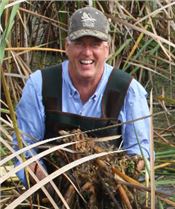LSU AgCenter Has A Storied History In Wetlands Management

LSU AgCenter coastal ecologist Andy Nyman working in the field.
Photo provided by Andy Nyman/LSU AgCenter
JOHNNY MORGAN
BATON ROUGE, LOUISIANA
Wetland conservation is always a hot topic in the state of Louisiana, but a well-kept secret is just how involved the LSU AgCenter has been, and remains, in the research.
LSU AgCenter coastal ecologist Andy Nyman said that wetland management includes sustainably harvesting wetland plants and animals; low- intensity management of surface water; and high-intensity control of surface water and ground surface elevation.
Nyman said wetland management today can be classified as prescribed fire; minimizing wetland ditching and offsite dredging; managing surface water within wetlands; using tidal or riverine energy to recreate wetlands; managing estuarine gradients; using dredged material to create wetlands; and constructing wetlands to treat wastewater.
“The management of wetlands can be traced back thousands of years, but that was more for survival instead of erosion control,” Nyman said. “People modified flooding and fire in wetlands because they needed something from the wetlands, like fish and ducks,” he said.
“But until the 1900s, they tended to drain the area for agriculture as soon as the cost of drainage could be offset by selling crops.”
“Wetlands began to be managed for muskrats in the 1920s because the fur was so valuable,” he added. “Soon wetlands also were being managed to increase the value of duck hunting leases and then alligator harvests. By the 1980s, people also began managing wetlands for shorebirds and wading birds.”
The topic of wetland management didn’t show up in research literature until the 1930s – and then it seemed to take off, he said.
“The very first master’s thesis at LSU that dealt with wetlands was from 1934 in the Department of Botany,” Nyman said. “But the second one, in 1941, was from the department of Agricultural Economics and Agribusiness, and it dealt with fur trapping in the marsh.”
Afterward, in 1953, civil engineering had a thesis on wetlands; then, in 1955, geology had one, he said.
“In 1956, the School of Renewable Natural Resources had the fifth one, which was an ecological study at the Rockefeller Refuge down on the coast,” he said. “And then, the next five theses and dissertations that addressed wetlands were all from RNR.”
The first LSU professor to publish an article in a peer-reviewed journal with “wetlands” in the title was Bob Chabreck, from RNR, in 1973. Nyman said that articles by LSU researchers in peer-reviewed journals reflecting wetland management and research became abundant in the late 1970s.
Nyman pointed out that wetlands management initially focused on the plants and animals that a landowner could harvest, but may now also include or focus on wetland functions that do not benefit the landowner, but instead benefit people offsite. Such topics include water quality improvement, flood reduction and carbon storage.
“Income to manage wetlands had primarily depended upon oil and gas, which is no longer abundant under Louisiana’s coastal wetlands,” he said. “Income from wetland functions such as waterfowl hunting, alligator harvests and carbon storage might partly justify protection and thus delay the conversion of wetlands into developed lands or open water.”
The LSU AgCenter continues to be a leader in wetland research, Nyman said.
“For example,” he said, “LSU’s College of Agriculture accounted for 19 percent of peer-reviewed journal articles addressing wetlands published by LSU researchers 2017. That was the second-most of the eight colleges represented that year. ∆
JOHNNY MORGAN: LSU AgCenter